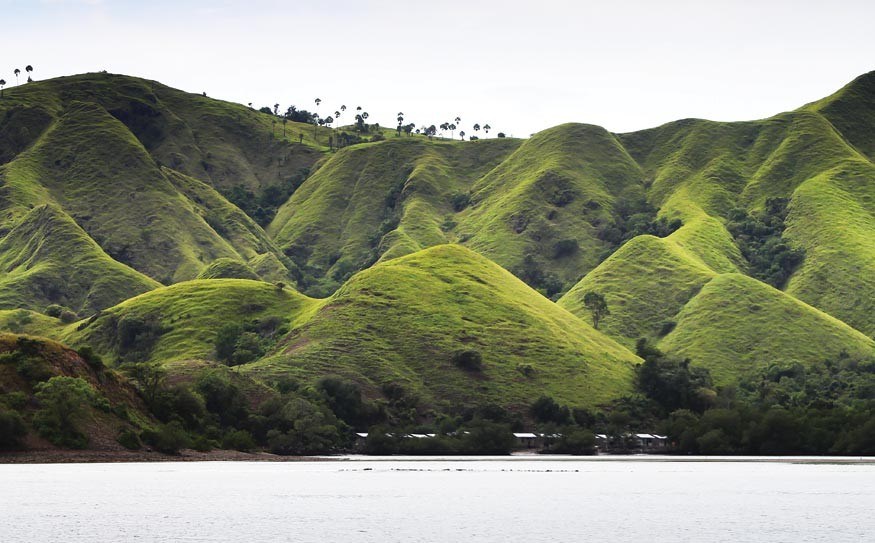The beast scuttles across the roof of the cave with unearthly, silent speed. Like a minion of Hades, it darts and lurches, doing whatever it can to evade the splash of my flashlight as I try to trace its progress above my head. Eventually, it finds a small crevice into which — incredibly — it manages to fold each of its six-inch-long jet-black legs.
It's a cave-dwelling storm spider — and it's massive — a frightening creature at any location, let alone here, underground in the pitch dark and damp folded stone of the caves of Batu Cermin, on Flores Island, Indonesia.
Flores Island lies along the northeastern fringe of the Indian Ocean, one link in a chain that stretches thousands of kilometres from Asia's southernmost tip, nearly as far as Australia's northernmost. It is but one of Indonesia's estimated 17,500 islands, and it is rich with both flora and fauna. Macaque monkeys, reticulated pythons and Javan deer have strongholds here, and its volcanic hills are thickly carpeted with palm, fig, clove and macadamia trees. It was among this lush, verdant tangle that, in 2003, the remains of a miniature hominid — Homo floresiensis — were found. Nicknamed the hobbit, some say that the descendants of this elfish creature still inhabit the island's dense forest.
Flores's main port is Labuan Bajo, an old fishing town turned tourist hub. Wooden ships of centuries-old design bob lazily in its harbour's tepid water, and a typical equatorial downpour will take only minutes to turn its dirt roads into brown rivers. This is the gateway to Komodo National Park, home to Komodo Island and its infamous, eponymous dragon, the world's largest living lizard. Between this island and that, exists some of the world's best diving.
Four kilometres east of Labuan Bajo, lies the rocky outcrop and labyrinthine passageways of Batu Cermin, or Mirror Rock. At around nine o'clock each morning, the sun's rays enter the subterrane at such an angle as to be divided and dispersed off the limestone chamber's reflective surfaces, creating the illusion that the rock walls are mirrored.
What are no illusion right now however, in the cave's dank confines, are the storm spiders.
They're not alone down here either; another unnerving presence makes a home of these spooky hollows.
I round another tight corner, contorting and squeezing my body through the cramped, rough passage that leads to the next cavern.
There's room in this one to stand, but I wouldn't want to. Pointing my light up to the roof it reveals hundreds of horseshoe bats. They hang in silent, inverted repose only metres above me while others flutter about haphazardly — flapping and whooshing around like giant, hairy moths. Some fly so close, their wings moving so near, that I can feel the push of cold air on my face. There's a terrible smell emanating from the void too. I point my light at the floor, and illuminate thick smatterings of bat feces.
The bats and the spiders are the largest full-time residents of the caves these days, but there were times when larger guests shared these lightless, pungent cavities.
Since the 1500s they have provided secret shelter for generations of Flores Island's indigenous peoples during their long history of colonization and conflict.
At first there was the oppressive rule of the Dutch to hide from. Later, it was that of the Portuguese and most recently the bayonets and bullets of Japanese soldiers during their brutal occupation through the Second World War.
Through troubled times over the past four centuries, people have hidden down here in the darkness, scraping and clambering past the same cold rough walls and squeezing into the same claustrophobic alcoves in which I now find myself. They stayed for as long as was necessary to conceal themselves from whatever episode of invasion and oppression presided above.
I crouch against a wet rock, its rugged protrusions digging into my leg and ribs, and wonder how long I would have lasted.
Not long, I decide, and, doubled over, I make my way back out along the awkward turns of the twisting tunnels. I've been in these close quarters for only a few hours, but they've been long and tiring. So, as I see the first hazy hints of daylight leaking into the cave, my progress towards them begins to quicken. Pausing briefly to rest, I can feel the beat of my heart and the sweat on my skin.
The light grows, and as I emerge through a curtain of vines veiling the cave entrance and into the full brightness of day, I inhale deeply and stretch widely.
It's good to be free, though all I have had to escape are the bats and the spiders.




